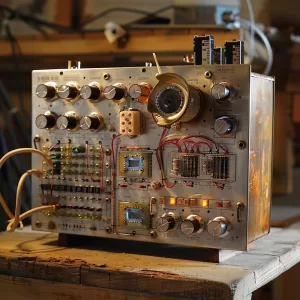
Unveiling the Secrets of Resonators: A Deep Dive into Exhaust Harmony
February 23 2024  1557
1557
Inquiry
Global electronic component supplier AMPHEO PTY LTD: Rich inventory for one-stop shopping. Inquire easily, and receive fast, customized solutions and quotes.
QUICK RFQ
ADD TO RFQ LIST
In this blog, we will unveil Resonators' secrets and equip you with the knowledge to understand and appreciate these essential components.
What is a Resonator?

What Does a Resonator Do?
- Amplification: Resonators in musical instruments, such as guitars and violins, amplify certain frequencies generated by air columns or strings, enhancing the tone and projecting sound.
- Filtering: By selectively absorbing undesirable frequencies, resonators can reduce noise and modify the overall sound. This is seen in automobile exhaust resonators, which attenuate unwanted high-pitched sounds.
- Tuning: A reference point for calibrating apparatus or fine-tuning other instruments is provided by tuned resonators, such as those found in tuning forks.
Types of Resonators
Resonators come in various shapes and forms, each with its unique sound characteristics:- Helmholtz resonator: This traditional design traps and cancels out particular frequencies using a side branch and a chamber.
- Absorption resonators: These reduce unwanted noise by using materials that absorb sound, such as fiberglass.
- Expansion chamber resonators: These resonators aim to cancel particular frequencies by increasing and decreasing the volume of exhaust gas.
Where are Resonators Located?
In the exhaust system, resonators usually sit between the muffler and the catalytic converter. The exact location of these can change based on the car in question and its exhaust system. Certain cars may even have several resonators placed in different ways to get the right combination of performance and sound.Video related to Resonator
How Resonator Works?
Resonators work magic because of their capacity to control sound waves. Consider the sound waves as they flow through the exhaust system, similar to pond ripples. These waves interact with the resonator's thoughtfully constructed chamber and side branches as they come into contact with them. Several things can occur, depending on the design of the resonator and the particular sound wave frequency:- Reflection: Some frequencies are reflected by the chamber and are subsequently sent back toward the engine, where they are essentially canceled out.
- Absorption: Unwanted sound energy is captured and dispersed by the resonator's sound-absorbing materials.
- Expansion and contraction: Variations in the chamber's volume can produce pressure waves that obstruct and neutralize particular frequencies.
Where Should Resonators be Placed?
Depending on the type of resonator and your goals, several factors determine the best location for it. Here are some examples:- Acoustic resonators: These are used to magnify specific frequencies in instruments such as violins and guitars. Depending on the instrument, its placement is crucial to how it works.
- Helmholtz resonators: These are used to cut down on noise in products like automobile mufflers. Usually, they are positioned close to the engine in the exhaust pipe.
- Microwave resonators: These are used to reheat food in microwave ovens. Usually, they are found in the middle of the oven cavity.
Can Resonators Go Bad?
While robust and relatively simple, resonators can eventually wear out or become damaged. Signs of a faulty resonator include:- Louder exhaust noise: A damaged or clogged resonator may be the cause of an increase in harshness or droning.
- Reduced performance: Partly the fault may be a malfunctioning resonator if your engine is slow to start or loses power.
- Visible damage: Check the resonator itself for any dents, cracks, or corrosion that may be compromising its efficacy.
Conclusion
In conclusion, resonators are important components that affect how your car performs and sounds, despite being disregarded a lot. You can recognize their contribution to a more comfortable and joyful driving experience by being aware of their types, functions, locations, and other factors. Recall that selecting, installing, or fine-tuning a resonator for your particular requirements can be greatly aided by speaking with a licensed technician or exhaust specialist.Populer Posts
EPM3064ATC144-10C
Intel
EPM3128ATC100-7/I100-10
Intel
EP20K300EBI652-3
Intel
EPM9560RC208-19
Intel
EPF10K30AQ240-1
Intel
EP20K60ERC240-1X
Intel
EP2C5F256-C8N
Intel
EPM7128ATC100-10
Intel
EPM7064STC100-7F
Intel
EPM7128AFI100-6
Intel
EP20K600CB652I7N
Intel
EP20K400EBC652-1XN
Intel
